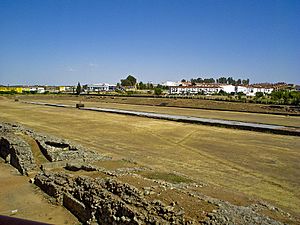Roman circus of Mérida facts for kids
|
Circo Romano de Mérida
|
|

View from the roof of the adjacent museum
|
|
| Location | Mérida (Badajoz), Spain |
|---|---|
| Coordinates | 38°54′58″N 6°20′16″W / 38.91611°N 6.33778°W |
| Type | Roman circus |
| Official name: The Roman Circus | |
| Type: | Cultural |
| Criteria: | iii, iv |
| Designated: | 1993 (17th session) |
| Part of: | Archaeological Ensemble of Mérida |
| Reference #: | 664-010 |
| Region: | Europe and North America |
| Area: | 5.9935 ha (14.810 acres) |
| Buffer zone: | 20.87 ha (51.6 acres) |
| Official name: Circo Romano | |
| Type: | Non-movable |
| Criteria: | Monument |
| Designated: | 13 December 1912 |
| Reference #: | RI-51-0000109 |
The Roman circus of Mérida (Spanish: Circo romano) is an amazing ancient building in Mérida, Spain. It was a huge arena used for exciting chariot racing events. Imagine a giant stadium built just for horse races!
This circus was designed like the famous Circus Maximus in Rome. It was also similar to other circus buildings across the Roman Empire. The Mérida circus is more than 400 meters (about 1,300 feet) long and 30 meters (about 100 feet) wide. It is one of the best-preserved Roman circuses you can find. It was so big that it could hold up to 30,000 people watching the races!
What is the History of the Roman Circus?
Historians are not completely sure about the exact date the circus was built. It seems to have been constructed around 20 BC. It was officially opened about 30 years later. The circus was built outside the city walls of Mérida. However, it was close to an important road. This road connected Mérida to other major cities like Toledo and Córdoba.
After the fall of the Western Roman Empire, the circus was still used a lot. This was even as Christianity became more popular in Spain. Chariot racing was seen as less "sinful" than other shows. These other shows took place in the Theatre and the Amphitheatre. So, the circus kept its purpose for a longer time.
What Can You See at the Circus Today?
The Roman circus in Mérida is still very well preserved. Many ancient circuses have been destroyed over time. This is because they took up a lot of flat land near cities. But the Mérida circus has kept many of its original parts.
You can still see:
- The Porta Pompae: This was the main entrance where parades would begin.
- The Porta Triumphalis: This was likely the gate where winners would exit in triumph.
- The spina: This was the long wall in the middle of the track. Chariots raced around it.
- The tribunal iudicium: This was the special area for the judges.
There is also a museum dedicated to the circus. It is located near the middle edge of the circus grounds. The museum lets you enter the fenced area around the ancient ruins. It helps you learn even more about this amazing Roman building.
See also
 In Spanish: Circo romano de Mérida para niños
In Spanish: Circo romano de Mérida para niños
- Archaeological Ensemble of Mérida
- Hippodrome – a Greek arena also used for chariot racing

